

This article is a reprint from Positive
Feedback Magazine, and is published with the express
permission of PF. Copyright (C) 1997, all rights reserved, Positive
Feedback Magazine.
Re-publication of articles from
Positive Feedback Magazine without the
prior and express written consent of Positive Feedback Magazine
is strictly prohibited.
April 1997
by Greg Weaver
Probably the most widely known (audio) fad is the use of special speaker cables, which are highly touted for their wondrous effects on the sound. Some of these cables are very well made, and I use them because they are very convenient for snaking across the floor without tangling. But affect the sound? Hardly.
Julian Hirsch, STEREO REVIEW, December 1992
Loudspeaker Cable Satori
Well my friends, if you believe the above statement from Julian "If I can't measure it - it doesn't exist" Hirsch, either quit reading right now and throw this periodical into that trash can over in the corner, or be prepared to be enlightened. There are two distinct camps, the objectivists (or measurers) and the subjectivists (or listeners). And until someone can show me a measurement or group of measurements that can differentiate one loudspeaker's ability to completely disappear and portray only the soundstage from one that cannot, for example, I will continue to adhere to the subjectivist camp!.
For years I had read this kind of drivel and had been able to accept it with relative ease. After all, didn't it say in all the popular magazines that wire was wire?
Cruising all my favorite Hi-Fi shops in the mid-seventies revealed the gaining popularity of some really nice looking and considerably thicker wires from the likes of Polk, Fulton and Monster Cable. But a 10 foot pair was starting at about $40, nearly 25 times the cost of the standard 18 AWG speaker wire of the same length! I was hard pressed to part with that much money for something that almost everyone acknowledged would make no difference. Forty dollars represented an awful lot of music in those days! For that amount, I could buy roughly 2.6 new Mobile Fidelity Sound LabsTM half speed albums, about 6.6 new standard releases, or about 13.33 used albums at most of the "Pre Owned" vinyl emporiums that I frequented. I can't speak for all of us who share this hobby, but to me, the equipment is merely a necessary means to an end, the music.
So why were people I knew beginning to spend the extra money on bigger, thicker and, dare I say it, sexier wire? Was it so all the girls they took back to their apartment would swoon at the thickness? Doubtful, but probably worth the try. No, there had to be some valid reasoning behind the craze.
The time finally came when I simply had to know. Semi reluctantly, I bough my first sturdily packaged and beautifully terminated pair of Monster Cable speaker wires, the first "mass market" name to really accost the plebeian hoards with claims of sonic bliss to be derived from their new breed of speaker cables.
Cursing the packaging for its reluctance in giving up its precious contents, I told myself yet again I had simply wasted the money. Shaking my head as I hooked up the shining sturdy gold pins, first at the back of my amp and then at each speaker terminal, I told myself that at least they did look nice and the gold pins probably would be quite durable. The cable itself, tough much thicker than any I had used, was quite pliable and easily routed around any obstacle on its way to the speakers. The clear jacket made it easy to see the bright, shinny high purity copper inside. So maybe, although these expensive snakes would sound no better that the 18 AWG "zip" cord I had been using, the money would not have been totally wasted.
I almost hesitated to fire up the system. It was as if the longer I postponed affirming my doubts about the wires the less stinging the insult would be. But I had to know.
I can't tell you for sure what the first piece I played through these new conduits was (I think it was The Alan Parsons Project's Tales of Mystery and Imagination), but I had to admit, maybe the purchase wasn't such a bad one. After listening to about ten albums to convince myself the experimental results were repeatable, I had to admit that although I had changed a supposedly passive link in the audio chain, there was more information! The highs were higher, the lows lower and there was nuance and detail previously unnoted.
I was so delighted with the change that all I cared about was digging into my library to see what new treasures I might uncover. I didn't think about types of wire, their properties or their construction. All I now knew was that different wires indeed sounded different.
Looking back on it now with my acquired electronics savvy, it becomes easy enough to accept. It is almost blatantly obvious that only if we impart absolutely no change to the signal as it travels from source to speaker, could it not have some resultant sonic effect. Unfortunately, every separate component in our music reproduction system (capacitors, diodes, resistors, transistors, even the solder joints which connect these basic components) reacts with the audio signal in some manner. This inevitable reaction thereby adds to, subtracts from, or combines with the audio signal, creating some form of distortion.
All you EE types, please keep in mind that I may tend to focus on a specific attribute of the property under consideration, rather than its entire set. This is not an electronics premier, it is a heuristic treatment. So please don't burst a vessel over the essential simplification! On the other hand, do take me to task if you feel I've misrepresented the trait or have oversimplified. Your feed back and dialogue is always welcomed.
When you are done reading this, hopefully you will have a little better understanding of how and why wires work and the overall effect they so significantly impart to your systems sound quality. You'll see why they must be considered dynamic components and how to better select and optimize the cabling you use with your system.
Not All Conductors Are Created Equal
To most of you, twin lead multi-stranded wire is the standard. You are probably using the variety and gauge of this type of wire sold to you (or maybe even given to you with your system) by the store where you purchase most of your gear. This wire consists of numerous very fine conductors bundled together side by side in a vinyl or plastic sleeve.
No big deal. This is a good tried-and-true, very flexible, easy to terminate wire for most installations. But what about the copper inside the insulation? Most of theses wires are made form a grade of copper that is known as Tough-Pitch Copper, or TPC. On average, TPC has about 1500 grains or crystals in each running foot and has an oxygen impurity content of approximately 235 parts per million. This is the quality commonly referred to as "lamp" or "zip" cord, and really should be avoided.
Better wire manufacturers, and in fact almost all the ones who build "audio" quality wire, use what has come to be known as Oxygen Free High Conductivity copper, or OFHC (This quality of copper is also referred to as "6 nines," because its purity typically approaches 99.9999%. There are even higher grades of copper. AudioQuest has a copper they call "Functionally Perfect Copper which is very slowly drawn. In this near-perfect process, it is claimed that individual copper crystals attain the length of about 700 feet!). This copper is drawn in a way that greatly reduces its oxygen content. OFHC contains approximately 40 parts per million and also reduces the grain per foot count to about 400. This grade of the metal represents a serious step up from TPC and is in part responsible for the higher cost (often a buck a foot or more) of the wire you see sold in audio stores.
This OFHC copper is still not perfect, but the higher purity is very desirable. If we look a the physical make up of a drawn copper wire, we see it consists of many separate grains of copper stuck together in a long line. Impurities within the copper, including oxygen, silver, iron, sulfur, antimony, aluminum and arsenic, coalesce at the grain surface, or boundary. This creates a much higher impedance to the electron flow by essentially forcing the electrons to have to "jump" those poorly conducting boundaries where grains touch. It's easy to see how reducing the impurity content and the number of grains per foot can make a wire a much more efficient conductor.
Let's take a look at the three previously mentioned major electrical properties of our conductor, inductance (the opposition to AC current presented by a circuit), resistance (the opposition to DC current presented by a circuit) and capacitance (an electrical characteristic which includes infinite resistance to DC current, diminishing impedance with increasing AC frequency and a phase lead for passing signals). Resistance causes equal losses at all frequencies while inductance causes varying degrees of loss in proportion to frequency. The higher the frequency, the higher the resultant loss. And although most engineers do not acknowledge that the capacitance presented by typical lengths of loudspeaker cable can affect the audio range, recent study has shown that such capacitance has a very real sonic factor, especially on a wires resonance. Resonance, for the purposes of our discussion, means the buildup of vibration, due to energy storage, and the continued vibration due to the specific periodic release of the energy stored in a circuit after the applied energy is removed.
![[ELECTRICAL REPRESENTATION]](wire/elec.gif) The figure right is an electrical model of a basic
18 AWG loudspeaker wire. It shows that per foot, you have on
average about .014 ohms of resistance, about .2 micro Henrys of
inductance and about 28 pico Farads of capacitance. These values
may vary widely with differing types of conductors and will
change during the application of the music signal. Generally, a
twenty five foot length of standard speaker cable will have about
one third of an ohm resistance, about five micro Henrys of
inductance and about 700 pico Farads (or .7 nano Farads) of
capacitance. My how 'dey do add up with distance. Obviously
shorter is better, more on that later.
The figure right is an electrical model of a basic
18 AWG loudspeaker wire. It shows that per foot, you have on
average about .014 ohms of resistance, about .2 micro Henrys of
inductance and about 28 pico Farads of capacitance. These values
may vary widely with differing types of conductors and will
change during the application of the music signal. Generally, a
twenty five foot length of standard speaker cable will have about
one third of an ohm resistance, about five micro Henrys of
inductance and about 700 pico Farads (or .7 nano Farads) of
capacitance. My how 'dey do add up with distance. Obviously
shorter is better, more on that later.
Any of you who have ever attempted crossover design (or have seen an electrical representation of one) can easily recognize the similarity between our per foot wire model and the textbook second order or 12 dB per octave low pass filter. After all, a 12 dB per octave low pass filter consists of a inductor in series with the driver and a capacitor in parallel with it. Gee, doesn't filter mean to intentionally separate or remove something from the whole? Won't that mean that some of the audio will be filtered or removed just by passing it through our wire? This arrangement allows lower frequencies to pass on to the driver while inhibiting, or filtering, the progress of the higher frequencies.
Induction and Resistance and Capacitance, Oh My!
Noel Lee, founder of Monster Cable, feels most distortions heard and attributed to cables can be categorized into three groups. The first deals with frequency integrity, how accurately the high and low frequencies are transmitted thought the conductor. The second deals with time domain integrity, how the conductor affects the resultant arrival times of differing frequencies as they pass through the conductor. Highs are known to travel much faster through most conductors than do lows. The third is the dynamic capability of the conductor, how rapidly and consistently it responds to dynamic changes across the audio spectrum. Lets examine how these effect our application.
One of today’s most talked about and more audible electrical characteristics of a cable's performance is known as the "skin effect". The dynamic factors of speaker wire, namely inductance and resistance, work in opposition to each other. Decrease one and the other invariable rises. Most of the difficulties of cable design are hidden until "skin effect" is taken into account. It works like a variable added inductance, raising resistance with frequency.
It occurs because locally circulating "eddie" currents in individual conductors cause the apparent inner core resistance to increase with frequency. This generates the behavior which causes the skin of the conductor to appear to have the least resistance to current flow. This then incites the electrons flowing in the electrical current through the conductor to impede to the outer surface (or skin) of that conductor. Because the tendency for this to occur also rises with frequency, the higher the frequency, the more pronounced the effect becomes.
According to Bill Low, president of AudioQuest, "The subjective effect in a single strand that is too large, anything above 18 gauge or so, is that the highest octave seems rolled off. The imaging, sense of space, and more subtle information seems to be lost" (Audio Video Interiors, January, 1992).
This effect becomes compounded in a multi-strand wire. The entire bundle acts like a single solid core conductor, with much worse effects. Any given individual strand can be found at a different location or depth in relation to the rest of the bundle depending on where we look for that strand within the bundle. It might be at the top when we look at it only one inch into the cable. Yet three feet further down the length of the cable, it might be found at the center or even the bottom of the bundle. Maintaining symmetry of the striations throughout the length of the bundle is so unrealistic as to be considered impossible.
This presents a problem in that, the higher the frequency, the more the current is going to be jumping form strand to strand in its desire to stay on the outermost conductor of the common bundle. Since there is also contact resistance between strands, not all of the current will be able to uniformly stay along the surface of the wire. Every time a strand leaves the surface and goes down into the bundle, some of the current will jump to a new strand in its effort to stay on the surface, thereby following the path of least resistance in accordance with natural law. Unfortunately, the point of contact between strands is actually a simple circuit exhibiting its own capacitance, inductance and diode rectification, presenting a whole host of problems. This happens thousands of times in cables and is responsible for most of the hashy and gritty sound common to them. This distortion mechanism is quite dynamic, extremely complex and tends to worsen over time.
Additionally, most of you who have ever played with electromagnetism in a school classroom will be able to appreciate this next difficulty. Running an electric current through a wire produces a magnetic field around that wire. As that magnetic field expands and contracts with the music signal, it will induce a current in any other conductor which lies within its field of influence. If a wire adjacent to it is carrying a field of its own, the magnetic fields around the two will cause them to attract or repel, just like two bar magnets. This electromagnetic effect serves to further increase the distortion caused by the skin effect. As the magnetic field around each strand changes, the current moves back and forth. This tends to alternately push or pull adjacent wires apart, further increasing the contact resistance.
Here is where something seemingly unimportant is said to come into play, the insulation jacket. Some manufacturers have attempted to attack this last problem in the form of applying a harder jacket. This harder jacket supposedly limits the mechanical movement possible by individual wires, limiting interaction within each bundle somewhat. Although this method is claimed by some manufacturers to yield higher dynamics and less distortion, taken by itself, it has little to no effect on the sonic quality of the wire in my experience.
As if all this weren't enough, this magnetic interaction applies to the second separately insulated bundle of striations just a millimeter or two away in the typical side by side twin lead cable. If that second wire is carrying a current of its own, as in the case of a musical signal from the amplifier, the resultant magnetic fields will exhibit a detrimental effect upon each other. The more powerful magnetic fields associated with the bass notes cause the greatest magnetic interaction, which in turn modulates the higher frequencies. The sonic results of this effect manifest themselves in the form of improper phase and time information, causing a broad band smearing of the music.
A common method used to combat this effect is to twist the two conductors around each other into what is called a twisted pair. Twisting the positive and the return conductor together will cancel out some of the intrinsic magnetic field, and as a bonus, reject outside interference as well. This is a very notable method of producing a higher quality speaker wire and is in common use today. The trick comes in the determining the pitch of the twist. It can be very different for differing gauges and configurations.
The capacitive nature of cable introduces group delay, a complex form of time-domain distortion. Group delay (a timing difference between one band of audio frequencies and the rest of the audio spectrum) could, for example, cause the music's harmonics to be reproduced at a slightly different time than the fundamentals.
One more concern is the potential for impedance mismatch between the two ends of our loudspeaker cable. Our loudspeaker wires connect the differing (and under an applied audio signal, widely varying) speaker impedances to the output of your amplifier. Mismatched impedances cause reflections, and those reflections increase the resonance, or ringing, problem. The end to end ringing builds into standing waves creating intermodulation products which impose themselves as brightness, graininess and other similar sonic artifacts which have become accepted as "normal".
Didn't someone say that wire can't possibly make a difference? Take that dullard out and apply a high voltage at low current to his testicles until he recants.
Wire Constructions
Let's take a look at some basic construction in the world of speaker wire and briefly examine the advantages and disadvantages of each.
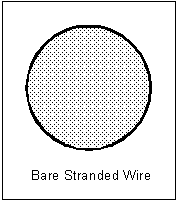 Bare stranded wire is the most common
type wire found in use today. Its advantages are that it is quite
pliable and affordable. In the minus column are its high relative
inductance, ease of corrosion, high "skin effect" and
low "Q" or resonant point. As we have already noted,
strand cables always force the musical signal to divide into a
multiplicity of paths, resulting in some signals arriving too
early, and some arriving too late. Though minute, these
differences destroy the true timing and subtle harmonic structure
of the music. This accounts for their typically resonant and
gritty sound. Although commonly accepted, I am sorry to have to
tell you that for true high fidelity, this wire type is
unacceptable.
Bare stranded wire is the most common
type wire found in use today. Its advantages are that it is quite
pliable and affordable. In the minus column are its high relative
inductance, ease of corrosion, high "skin effect" and
low "Q" or resonant point. As we have already noted,
strand cables always force the musical signal to divide into a
multiplicity of paths, resulting in some signals arriving too
early, and some arriving too late. Though minute, these
differences destroy the true timing and subtle harmonic structure
of the music. This accounts for their typically resonant and
gritty sound. Although commonly accepted, I am sorry to have to
tell you that for true high fidelity, this wire type is
unacceptable.
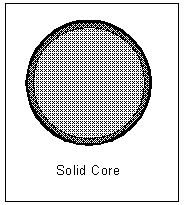 Solid core wire has good value, given
the performance per dollar ratio, with most of today’s
systems. It is simple, has low DC resistance per unit area and
offers a good resistance to capacitance ratio. On the negative
side of the equation, it is stiff and therefore hard to handle,
has a high relative inductance at higher frequencies, offers a
high DC to AC resistance ratio and has a low "ring"
point. Overall sound is much better damped and the sound stage is
vastly improved, but some brands can still tend toward gritty and
harsh performance. You will find most varieties of this
construction to use the twisted pair geometry to help negate
induction concerns. The most stalwart proponent of this conductor
type has been Tara Labs, from their original Space And Time7
cable introduced in the '80's, through their current Prism and
RSCTM cables .
Solid core wire has good value, given
the performance per dollar ratio, with most of today’s
systems. It is simple, has low DC resistance per unit area and
offers a good resistance to capacitance ratio. On the negative
side of the equation, it is stiff and therefore hard to handle,
has a high relative inductance at higher frequencies, offers a
high DC to AC resistance ratio and has a low "ring"
point. Overall sound is much better damped and the sound stage is
vastly improved, but some brands can still tend toward gritty and
harsh performance. You will find most varieties of this
construction to use the twisted pair geometry to help negate
induction concerns. The most stalwart proponent of this conductor
type has been Tara Labs, from their original Space And Time7
cable introduced in the '80's, through their current Prism and
RSCTM cables .
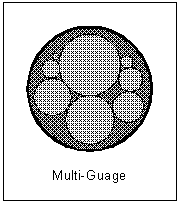 The multi-gauge configuration
yields slightly lower inductivity and a much lower
electro-mechanical resonance due to the elimination of strand
multiplicity. It still has a relatively high inductivity and a
high likelihood of corrosion in non-Litz applications and is
quite pricey. Kimber Kable is the strongest advocate of this
technique, and for good reason. The stuff sounds pretty good.
Kimber's methodology is to braid the differing diameter wires
together, yielding at once significant induction management and a
very unique looking cable. The 4TC version is available at $5 a
foot (and the step up 8TC at $9 a foot), the price of admission
is certainly not outrageous.
The multi-gauge configuration
yields slightly lower inductivity and a much lower
electro-mechanical resonance due to the elimination of strand
multiplicity. It still has a relatively high inductivity and a
high likelihood of corrosion in non-Litz applications and is
quite pricey. Kimber Kable is the strongest advocate of this
technique, and for good reason. The stuff sounds pretty good.
Kimber's methodology is to braid the differing diameter wires
together, yielding at once significant induction management and a
very unique looking cable. The 4TC version is available at $5 a
foot (and the step up 8TC at $9 a foot), the price of admission
is certainly not outrageous.
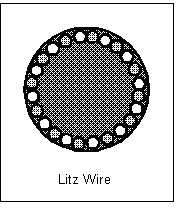 The "litz" wire is
one of the most widely used wire constructions in use today, in
both loudspeaker and signal cables. This wire is derived of many
finer gauge conductors independently coated with an insulator,
and is usually constructed in such a fashion as to have two
distinct signal paths in one bundle, so that both the plus and
minus run are under the same insulator. Its qualities include low
inductivity, good conductor resistance and inductance to cable
capacitance ratios, and it doesn't corrode! Although it sounds
quite good, it can suffer from sever capacitive effect in longer
lengths. More on this particular construction later as it is one
of the most widely accepted "good sounding"
constructions on the market. Cello Strings III, and AudioQuest's
Hyper-Litz are good examples of this construction.
The "litz" wire is
one of the most widely used wire constructions in use today, in
both loudspeaker and signal cables. This wire is derived of many
finer gauge conductors independently coated with an insulator,
and is usually constructed in such a fashion as to have two
distinct signal paths in one bundle, so that both the plus and
minus run are under the same insulator. Its qualities include low
inductivity, good conductor resistance and inductance to cable
capacitance ratios, and it doesn't corrode! Although it sounds
quite good, it can suffer from sever capacitive effect in longer
lengths. More on this particular construction later as it is one
of the most widely accepted "good sounding"
constructions on the market. Cello Strings III, and AudioQuest's
Hyper-Litz are good examples of this construction.
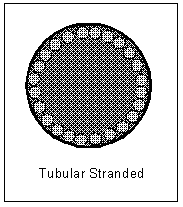 The tubular arrangement offers low
inductivity and can be reasonably flexible in stranded versions.
Its drawback is a high resistance for a given length. Tubes work
by the very virtue of their thinness. So as an audio conductor
they are limited by the fact that their resistance (and related
cable capacitance) goes up as the conductor inductance goes down
giving poor resistance to capacitance ratios. Their transient
response is typically quite good offering striking control of
resonance which ultimately yields very good time domain behavior.
Most tubular constructions incorporate the "Litz"
configuration. Both Audiostream's FMS Black and Straight Wire's
Duet rely on this geometry to varying degrees.
The tubular arrangement offers low
inductivity and can be reasonably flexible in stranded versions.
Its drawback is a high resistance for a given length. Tubes work
by the very virtue of their thinness. So as an audio conductor
they are limited by the fact that their resistance (and related
cable capacitance) goes up as the conductor inductance goes down
giving poor resistance to capacitance ratios. Their transient
response is typically quite good offering striking control of
resonance which ultimately yields very good time domain behavior.
Most tubular constructions incorporate the "Litz"
configuration. Both Audiostream's FMS Black and Straight Wire's
Duet rely on this geometry to varying degrees.
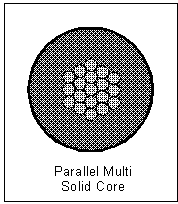 Parallel multi solid core
wire, although offering lower inductivity than some of the other
wires, can be limited by high dielectric involvement. While the
multiple parallel paths reduce inductive energy storage which
fuels resonance, as the audio signal represents a variable
electrical field, it must travel in the dielectric medium
surrounding the conductor. The primary effect of the dielectric's
interaction is to reduce the speed of transmission of the signal,
which introduce small yet significant time domain behavioral
problems. They are usually quite bulky and exhibit great
difficulty maintaining the symmetry throughout the cable,
especially as the strand numbers increase, making them labor
intensive. Although the simplest of these constructions are
successfully used as interconnects, some have found limited
following as speaker wire. AudioQuest uses this geometry in a
number of its Hyper-Litz constructions such as the Indigo and
Midnight. A tubular assembly of several twisted groups of solid
core litz conductors is also used by Monster Cable in their M
series of speaker cables.
Parallel multi solid core
wire, although offering lower inductivity than some of the other
wires, can be limited by high dielectric involvement. While the
multiple parallel paths reduce inductive energy storage which
fuels resonance, as the audio signal represents a variable
electrical field, it must travel in the dielectric medium
surrounding the conductor. The primary effect of the dielectric's
interaction is to reduce the speed of transmission of the signal,
which introduce small yet significant time domain behavioral
problems. They are usually quite bulky and exhibit great
difficulty maintaining the symmetry throughout the cable,
especially as the strand numbers increase, making them labor
intensive. Although the simplest of these constructions are
successfully used as interconnects, some have found limited
following as speaker wire. AudioQuest uses this geometry in a
number of its Hyper-Litz constructions such as the Indigo and
Midnight. A tubular assembly of several twisted groups of solid
core litz conductors is also used by Monster Cable in their M
series of speaker cables.
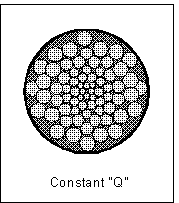 The constant "Q" , or Golden
Ratio wire uses a unique approach (the "Golden
Ratio" was first hit upon by the ancient Greeks, and is
specifically a ratio of 1.618:1). The conductor is made up
of very fine strands (starting around 41 AWG), built up in
layers, each successive layer a Golden Ratio larger and reversed
in direction. Every strand is discreet, offering hundreds of
paths homogenizing their fields at the conductor level. This
construction offers very low inductivity and resistance for the
given size, allows excellent capacitance and resistance to
inductance ratios, and eliminates electro-mechanical resonance
even more so than the multi-gauge geometry. But due to their
complexity they are labor and time intensive to build and
therefore very expensive. They sound very good, if you can afford
them, definitely try them if your retailer will loan you a set
for appraisal before purchase. This is the bread and butter
approach of George Cardas, of Cardas Audio.
The constant "Q" , or Golden
Ratio wire uses a unique approach (the "Golden
Ratio" was first hit upon by the ancient Greeks, and is
specifically a ratio of 1.618:1). The conductor is made up
of very fine strands (starting around 41 AWG), built up in
layers, each successive layer a Golden Ratio larger and reversed
in direction. Every strand is discreet, offering hundreds of
paths homogenizing their fields at the conductor level. This
construction offers very low inductivity and resistance for the
given size, allows excellent capacitance and resistance to
inductance ratios, and eliminates electro-mechanical resonance
even more so than the multi-gauge geometry. But due to their
complexity they are labor and time intensive to build and
therefore very expensive. They sound very good, if you can afford
them, definitely try them if your retailer will loan you a set
for appraisal before purchase. This is the bread and butter
approach of George Cardas, of Cardas Audio.
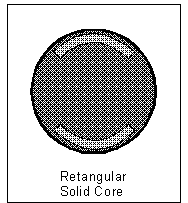 The Rectangular Solid CoreTM
construction is a bit of a conglomeration. Slowly drawn and super
annealed pure OFHC copper is used. The proprietary solid
rectangular cross section reduces high frequency loss and allows
for a very high degree of phase linearity. The RSCTM
design offers more than twice the skin-to-cross-section ratio of
round conductors having equal mass. Two RSCTM strands
are then helically wound around an aerospace polymer center to
make one approximately 14 gauge conductor in an attempt to
provide sufficient capability for dynamic power, low frequency
transmission and spatial definition (Years of research by
many different designers and manufacturers has pretty much
settled on the "optimum" diameter of a conductor. That
diameter is about .040", or 20 mils, and has been chosen
because it is the largest diameter attainable before high
frequency attenuation at 20 kHz occurs due to the skin effect).
The inherent advantage of this design is that it provides a
fairly uniform frequency to current distribution in the conductor
giving it outstanding overall performance. This is a design which
has been patented by Tara Labs, the latest iteration of the RSCTM
going for about $800 for an eight foot pair. The sonic
performance of this construction can be summed up in one word -
sweet!
The Rectangular Solid CoreTM
construction is a bit of a conglomeration. Slowly drawn and super
annealed pure OFHC copper is used. The proprietary solid
rectangular cross section reduces high frequency loss and allows
for a very high degree of phase linearity. The RSCTM
design offers more than twice the skin-to-cross-section ratio of
round conductors having equal mass. Two RSCTM strands
are then helically wound around an aerospace polymer center to
make one approximately 14 gauge conductor in an attempt to
provide sufficient capability for dynamic power, low frequency
transmission and spatial definition (Years of research by
many different designers and manufacturers has pretty much
settled on the "optimum" diameter of a conductor. That
diameter is about .040", or 20 mils, and has been chosen
because it is the largest diameter attainable before high
frequency attenuation at 20 kHz occurs due to the skin effect).
The inherent advantage of this design is that it provides a
fairly uniform frequency to current distribution in the conductor
giving it outstanding overall performance. This is a design which
has been patented by Tara Labs, the latest iteration of the RSCTM
going for about $800 for an eight foot pair. The sonic
performance of this construction can be summed up in one word -
sweet!
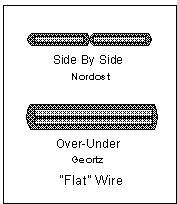 Flat cables offer a fairly low overall
inductance, a near match of characteristic impedance and speaker
impedance and high rejection of EMI. They have the ability to
pass square waves with remarkable ease, indicating their tendency
to handle musical transients extremely well. They typically sound
remarkably open by their low inductive nature (you've heard the
DC to light analogy). But almost all flat conductors I've
listened to exhibit a overall lightness in deep bass, rolling off
around 40 to 50 Hz, a result I would attribute to the high
capacitive nature of the design. Goertz is the biggest devotee of
the flat cable today (AudioQuest's F-14, F-18 and F-88 cables,
although referred to as flat cables, are actually several bundles
of Hyper-Litz conductors placed side by side in the insulating
jacket) and they offer it in two sizes, one in silver. The MI 1
is .4 inches wide and .04 inches thick (and fairly cost effective
at about $4.20 a foot) while the MI 2 is .8 inches wide and .04
thick and is available in an Ag II silver conductor design as
well as in "6 Nines" copper. The result of placing two
solid core .8 inch wide 14 gauge equivalent conductors a mere
three one thousandths of an inch apart, one atop the other, is to
really drive down the inductance, raising the capacitance at the
same time. Since the characteristic impedance is the square root
of the inductance divided by the capacitance, that allows for a
characteristic impedance that is in the single digits. This is
not so with most other designs, excepting for the highly complex
"network" designs.
Flat cables offer a fairly low overall
inductance, a near match of characteristic impedance and speaker
impedance and high rejection of EMI. They have the ability to
pass square waves with remarkable ease, indicating their tendency
to handle musical transients extremely well. They typically sound
remarkably open by their low inductive nature (you've heard the
DC to light analogy). But almost all flat conductors I've
listened to exhibit a overall lightness in deep bass, rolling off
around 40 to 50 Hz, a result I would attribute to the high
capacitive nature of the design. Goertz is the biggest devotee of
the flat cable today (AudioQuest's F-14, F-18 and F-88 cables,
although referred to as flat cables, are actually several bundles
of Hyper-Litz conductors placed side by side in the insulating
jacket) and they offer it in two sizes, one in silver. The MI 1
is .4 inches wide and .04 inches thick (and fairly cost effective
at about $4.20 a foot) while the MI 2 is .8 inches wide and .04
thick and is available in an Ag II silver conductor design as
well as in "6 Nines" copper. The result of placing two
solid core .8 inch wide 14 gauge equivalent conductors a mere
three one thousandths of an inch apart, one atop the other, is to
really drive down the inductance, raising the capacitance at the
same time. Since the characteristic impedance is the square root
of the inductance divided by the capacitance, that allows for a
characteristic impedance that is in the single digits. This is
not so with most other designs, excepting for the highly complex
"network" designs.
Exotica
This by no means covers all designs available today, just those which use a basically passive approach. Many other more esoteric approaches exist and almost all of those are quite expensive.
Take Purist Audio Designs, for example. They use a complex water based fluid as their cables primary insulator. This exotic insulator is said to provide for extreme protection from environmental vibration in their Proteus Speaker Cable (not to mention the fact that now you can obsess on cables which can spring a leak)! This is done in a effort to addresses the possibility for a cable to have a microphonic effect. Simply put, this means that the cable may reintroduce an analog of the sound produced by the speaker into the feedback loop with varying degrees of detrimental audible results! And, hey, they only cost $4160 for a ten foot pair!
One of the more rapidly growing design camps are those of the so called "Network" approach. In this active approach, some type of electronic network (none of the manufacturers seem willing to give specific details) is placed in line with the cable at its termination.
Network designs attack what has come to be called the Power Factor. Because power is a product of voltage and current, any change in voltage or current changes the power factor. When the cable's signal varies with frequency, the cable conducts more power at certain frequencies than at others, causing a sonic emphasis or de-emphasis on some portion/portions of the audio spectrum.
The concept of this approach is to attempt to lower the resonant point of the conductor where inductance changes to capacitance. That is at approximately 1300Hz (Stereophile, May 1995), generally speaking. While resistance is relatively easy to design around, inductance and capacitance on the other hand, because they are reactive values and react to AC Signals, can create engineering nightmares (Because of the inherent storage nature of capacitance and inductance, they resist surrendering all the signal they carry and contribute greatly to the resonant character of the conductor under examination. Capacitance is more reactive at low frequencies, while inductance is more reactive to the highs. By more reactive, I mean that the effort required to transmit the audio signal increases, so capacitance resists the passing of low frequency components, while inductance resists the high frequencies). . The true enemies being confronted by designers are energy storage, resonance and field radiation.
Below 1500 Hz, cables offer increased resistance and greater storage of the signal. As this mechanism develops, numerous interactions occur broad band, not just at a select frequency, and cause irretrievable loss through cancellation.
The biggest proponents of this design approach are Musical Interface Technologies and Transparent Audio. MIT offers an eight foot pair of their MH-850 Multi-Bandwidth CVT Terminator Loudspeaker Cable for a mere $9000 while Transparent Audio offers the much more realistically priced eight foot pair of their Music Wave Loudspeaker Cable for a mere $4000! (In all fairness, MIT does build a more affordable unit, the MIT Terminator 3, which sells for $175 per eight foot pair. No personal experience here, but friends rave about this cable's timing properties and natural ambience).
Let's get serious! While every review of these cables I've read (I'm still trying to talk one of the manufacturers into loaning me a set for personal evaluation) is filled with lots of absolutes, for nearly the price of an automobile, they damn well should represent perfection! This simply illustrates one of my long time axioms, that a 2 to 5% increase in performance requires at least a squaring of the current price range. In this case, the cables can cost more than most spend on an entire system.
So What Can I Do About It?
As I have attempted to demonstrate, there are only three factors which we as end users can apply with varying degrees of success to the forces acting to disrupt our sound as it travels thorough our chosen wire. These are the type and quality of the conducting material the wire is drawn from and its companion dielectric and insulator, the type and physical construction of the cable design and the cables overall running length. A basic understanding of these allow us to pick, or even build, a wire that will yield significantly better performance in our system, to the point of giving our system a new sound. Indeed, picking the correct wire can yield a level of change similar to buying new speakers or a new source device.
Conductor materials of all types have been used, obviously with varying degrees of success. Silver is used by companies including Kimber, Siltech and Audioquest, and with outstanding results. Roy Kimber's 4AG is a killer sounding wire (at $100 a foot) and the AudioQuest Dragon, made of FPSTM , is a staggering $300 a foot. Although silver is indeed a slightly better conductor than copper (silver actually has about the highest conductivity percentage known without supercooling. It is given as 99% conductive, while copper a close second at 98%) and does not corrode as easily a untreated copper, it is pretty damaging to the wallet of most of us working stiffs. Most manufacturers have elected to stay with "6 Nines" copper, and this is the most logical financial choice for most budgets. But, if you can afford the price of admission, you should not overlook silver wires.
This does not mean that any wire using silver in its construction is necessarily superior to one using copper. In my experience, the mere quality of the conductor (or the insulator or dielectric used for that matter) alone, has very little to do with that wires resultant sonic performance. The use of such quality materials by themselves are meaningless if the basics of good design are overlooked.
The physical construction of the wire can be shown to have the most demonstrable effect on the final sound of any cable. The idea of the "twisted pair" geometry is now becoming so common that some manufacturers have even taken to twisting bare stranded cable pairs with some degree of success. It works, folks. It works real well. I hope all of you get a chance to experiment with this type of construction, either by buying it or by building your own.
As for building your own, I heartily encourage this type of endeavor. You learn so much by doing it yourself! You can save money, have fun and get better performance from your system. What more could you ask from this hobby?
For the money, the twisted pair solid core geometry simply cannot be beaten in my opinion. Until I moved from dynamic speakers to electrostatics, this geometry yielded the highest performance per dollar. My most pleasing sounding construction came from twisting two 14 AWG solid core conductors together at a pitch of about one full revolution every three inches for the plus run (Call electrical supply houses. I found this wire available for under 10 cents per foot. Believe me, the time it takes struggling to twist (use a variable speed drill) and terminate them is well worth the effort!). I repeated this procedure with two 14 AWG solid core conductors with a different color insulation at the same pitch for the return run. The construction was then completed by twisting the two finished "twisted pair" wires into a final "twisted pair" pair. The results are simply wondrous with most power/speaker combinations. Substantially increased dynamics, higher highs, lower lows and a dramatically more focused soundstage than with any variety stranded speaker wire.
If you're not the adventurous type, right now the Audio Advisor (800-942-0220) is practically giving away Tara's Phase II/TFA speaker cable, a long time acknowledged over achiever of this construction type. This wire naturally excels at imaging and soundstaging, has fairly good time coherence and solid bass performance. You'll probably find it unbeatable for the clams!
The final method of eliminating the sound throttling effects of speaker wire is to make sure the running distance is as short as possible. The easiest way to achieve this is to relocate the amplifier/receiver to the floor between the speakers, using a longer signal cable from the pre-amp/source if necessary (this involves a similar set of considerations, but that is a different issue, literally). Then use two equally matched lengths of loudspeaker cable. Since your speakers will probably be no further that six or eight feet apart in most average sized listening rooms, one other less obvious advantage of this method is the decided shortening of the length of cable needed. Often times, going to two 5 or 6 foot lengths of loudspeaker cable instead of two 12 or 15 foot (or longer!) lengths will allow you to move up in quality yet still stay within your budget!
The End Of The Line
All this energy spent on learning, listening and selection of the most pleasing cable for our needs will be completely wasted if the cable isn't connected to the amplifier and speaker effectively and securely. Although the termination is not normally thought of when describing a wire's performance, it most certainly plays a key role in current and signal transfer.
Most speakers and amplifiers today come equipped with five way binding posts (The term "five way binding post" refers to the number of terminations which the post will accept. They include: 1) bare twisted wire; 2) spades; 3) pins; 4) single banana jacks; and 5) dual banana jacks). If your equipment uses the spring loaded clip jobbies, you should resign yourself to either using only pin terminations or possibly modifying your equipment by installing five way binding posts. When possible, the addition of the post is not radically expensive or difficult, but such mods will void any manufacturers warranty, so proceed at your own risk and only after you have given the idea plenty of thought. If you are inexperienced at such modifications, take your equipment to a reputable local electronics service shop and explain what you would like to have done. Always check on the shop's warrantee on work performed and get a quote in writing before authorizing the work.
Prevailing theory on wire termination has it that spade terminals offer the most secure connection, yielding the highest current transfer in the business. Well, prevailing theory outside the world of Ivor Tiefenbrun of Linn, anyway, who contends that the banana plug is sonically superior! What ever termination type you chose, try to get one which is plated to help prevent corrosion and pitting over time. Most come plated in gold, but it's up to you.
If you purchase pre-terminated wires, the solder joint between the cable and the connector should be both strong and efficient. Be sure to examine your new cables before installing them for a good physical and electrical connection between the wire and termination. Quality control is quite excellent these days, but every once and a while, a poor connection gets through. If you discover any problems, exchange them at your dealer.
If you terminate your cables yourself, be sure to heat the wire thoroughly when soldering the termination to the cable. Let the solder flow through the wire and around the entire connection, don't just heat up the termination and tack the cable to it.
Finally, make sure that the connections at both the amplifier and the speaker are also clean and solid. A poor connection at either end of the cable negates all the thought, care and money you have put into choosing the right wire for your application. You'll be giving up a lot in terms of conductivity and signal path if they are loose or dirty! Routine checks once a month or so help to assure that they have not loosened and alert you to the build up of dirt and corrosion.
What's All This Then?
These days my modified Acoustat Spectra 2+2 Medallion's are singing away with a very unusual yet undeniable sweet sounding cable configuration of my own development.
For the plus run, I'm using a helically woven Litz wire (which I acquired some time ago). It was originally built to carry both positive and negative run under one sheath, so the two groups are braided together at near right angles to each other around a center dielectric of polyethylene, then insulated in a transparent PTFE jacket. However, rather than use the twin conductor capability of this cable, I am incorporating both of the separate braids together to carry only the positive run, in essence utilizing a tubular Litz configuration.
This application offers some serious sonic benefits. First, I am able to enjoy all the electrical benefits of Litz wire, with its low inductivity and its good resistance and inductance to capacitance ratios. Secondly, the electromagnetic benefits of the cable allow the negation of the adverse qualities of "skin effect" yielding a much lower phase distortion since I'm using it in a tubular configuration. It also permits all of the inherent advantages just mentioned to be synergised with the unique sound quality of tubular wires (like excellent transient capability and exemplary time domain coherence).
The minus run is a twisted 10 AWG equivalent multiple conductor, solid core wire. This return run offers significantly better damping of the loudspeaker driver system than most any other configuration. This added control helps reduce any extraneous driver excursion/planer motion and effectively gives the amplifier more headroom for a cleaner, tighter and more detailed sound. And it adds significantly to the imaging abilities of the pair.
I've gotta' tell ya, although this stuff's not exactly cheap to build, costing some forty bucks a foot, it is pure magic. The first time I fired up the ol' system with these unwieldy, grotesque-looking, scintillating cables, I got chills. Traci, the apprentice-in-residence, heard the difference from the video room (adjoining the audio room via an arched doorway) while playing Super Mario on her N.E.S.! No Bull!
It became immediately apparent that both the width of the soundstage, and in particular the vertical placement of the instruments within it, was much better articulated. There was a more concise overall focus, with individual voicings much more precisely delineated, left to right but especially front to back and vertically.
Additionally, a full frequency "unveiling" had taken place, allowing and even greater sense of delicacy and ease than before. The upper registers had become slightly more open. Complex musical passages were relieved of any hit of congestion. The acoustic of each recording became more evident. The space "of" and air "around" each instrument was much more substantial and apparent. Overall liquidity had increased ever so slightly.
The lower registers were given to blindingly fast transients. Tom attacks were a sheer thrill. Kettle drums were ferocious. Double bass and bass guitar now packed even more of that realistic weight and body that so many cable systems are unable to get right.
The harmonics were in near perfect relation to the fundamentals in such a coherent manner that I simply reveled in the systems ability to involve me in the rhythm, pace and drive of the recording.
Connecting this wire between my subwoofer amplifier (which is actively crossed over at 40 Hz) and subwoofer provided a surprisingly pleasant increase in the heft of the lowest register. There was much more control exhibited. Any vestige of overshoot and ringing seemed completely banished. Transients were breath taking, exhibiting much more control during the decay. The system not only seemed to go lower (I didn't measure the response) but it was much more concussive, with the lowest frequencies slamming into you rather than just vibrating you. It was a very welcomed change.
I have not experienced a more wholesale increase in system sound quality than I experienced with their addition. It is the most significant "tweak" I have made since I modified my Linn Sondek LP12.
Generally speaking, you should try to use a cable of a 14 gauge equivalent or larger. Budget minded image and bass freaks should use twisted pair solid core geometries. Shorter is always better. Unequal lengths are verboten. Try any wire someone is willing to loan you! What have you got to lose? Don't be afraid to experiment!
The next time someone tells you that wire is wire and has no effect on the sound, stand up and tell 'em it just isn't so! Don't let anybody tell you that loudspeaker cable is not a dynamic component! And tell 'em you know 'cause you read it here. That should start an interesting conversation!
...Greg Weaver
gregw@soundstage.com
![[POSITIVE FEEDBACK CARTOON]](pics/pf_cart1.jpg)
All cartoons are Copyright (C) Positive Feedback
Magazine, all rights
reserved; re-publication of Positive Feedback cartoons without
the
prior and express written consent of Positive Feedback Magazine
is
strictly prohibited.
MORE ABOUT POSITIVE FEEDBACK MAGAZINE
Subscriptions to Positive Feedback are $30.00/six issues in the US, US $45.00 in Canada, and US $75.00 in the rest of the world. VISA/MC are welcome.Positive Feedback Magazine may be reached for subscription in any of the following ways:
Positive Feedback Magazine
2939 N.E. 155th Avenue
Portland, OR 97230
(503) 256-1300 (PF Business Office--subscriptions)
(503) 257-2002 (PF Editorial Office)
(503) 254-3866 (FAX)
Via email at davidr@ix.netcom.com
http://www.audioweb.com/newsstand/positivefeedback
Letters responding to any PF article posted on SoundStage! may be emailed to the email address above, or snail mailed to the magazine address.
Positive Feedback welcomes submissions of manuscripts as candidates for publication. Please do not send irreplaceable files, as Positive Feedback accepts no responsibility for the loss or damage of such articles.